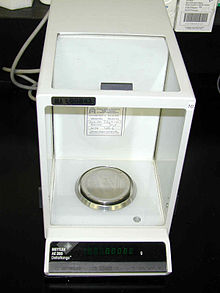Difference between revisions of "Gravimetric Analyzers"
(Created page with "Category:Analyzing{{Knoppen}} <noinclude><!------------------------------------------------ * READ THIS FIRST * Only edit this page if you can improve the content. * Imprope...") |
m |
||
| (One intermediate revision by one other user not shown) | |||
| Line 1: | Line 1: | ||
[[Category:Analyzing]]{{Knoppen}} | [[Category:Analyzing]]{{Knoppen}} | ||
[[File:Gravimetric analyzers.jpg|thumb|right|Gravimetric Analyzer]] | |||
'''Gravimetric Analyzer''' describes a set of methods in analytical chemistry for the quantitative determination of an analyte based on the mass of a solid. A simple example is the measurement of solids suspended in a water sample: A known volume of water is filtered, and the collected solids are weighed. | |||
In most cases, the analyte must first be converted to a solid by precipitation with an appropriate reagent. The precipitate can then be collected by filtration, washed, dried to remove traces of moisture from the solution, and weighed. The amount of analyte in the original sample can then be calculated from the mass of the precipitate and its chemical composition. | |||
In other cases, it may be easier to remove the analyte by vaporization. The analyte might be collected perhaps in a cryogenic trap or on some absorbent material such as activated carbon and measured directly. Or, the sample can be weighed before and after it is dried; the difference between the two masses gives the mass of analyte lost. This is especially useful in determining the water content of complex materials such as foodstuffs. | |||
==Advantages== | |||
Gravimetric analyzers, if methods are followed carefully, provides for exceedingly precise analysis. In fact, gravimetric analyzers was used to determine the atomic masses of many elements to six figure accuracy. Gravimetry provides very little room for instrumental error and does not require a series of standards for calculation of an unknown. Also, methods often do not require expensive equipment. Gravimetric analyzers, due to its high degree of accuracy, when performed correctly, can also be used to calibrate other instruments in lieu of reference standards. | |||
==Disadvantages== | |||
Gravimetric analyzers usually only provides for the analysis of a single element, or a limited group of elements, at a time. Comparing modern dynamic flash combustion coupled with gas chromatography with traditional combustion analysis will show that the former is both faster and allows for simultaneous determination of multiple elements while traditional determination allowed only for the determination of carbon and hydrogen. Methods are often convoluted and a slight misstep in a procedure can often mean disaster for the analysis . Compare this with hardy methods such as spectrophotometry and one will find that analysis by these methods is much more efficient. | |||
==Example== | |||
A chunk of ore is treated with concentrated nitric acid and potassium chlorate to convert all of the sulfur to sulfate . The nitrate and chlorate are removed by treating the solution with concentrated HCl. The sulfate is precipitated with barium (Ba2+) and weighed as BaSO4. | |||
==Sources== | |||
[http://en.wikipedia.org/wiki/Gravimetric_analysis Wikipedia Gravimetric Analyzers] | |||
Latest revision as of 02:47, 11 March 2014
Gravimetric Analyzer describes a set of methods in analytical chemistry for the quantitative determination of an analyte based on the mass of a solid. A simple example is the measurement of solids suspended in a water sample: A known volume of water is filtered, and the collected solids are weighed. In most cases, the analyte must first be converted to a solid by precipitation with an appropriate reagent. The precipitate can then be collected by filtration, washed, dried to remove traces of moisture from the solution, and weighed. The amount of analyte in the original sample can then be calculated from the mass of the precipitate and its chemical composition. In other cases, it may be easier to remove the analyte by vaporization. The analyte might be collected perhaps in a cryogenic trap or on some absorbent material such as activated carbon and measured directly. Or, the sample can be weighed before and after it is dried; the difference between the two masses gives the mass of analyte lost. This is especially useful in determining the water content of complex materials such as foodstuffs.
Advantages
Gravimetric analyzers, if methods are followed carefully, provides for exceedingly precise analysis. In fact, gravimetric analyzers was used to determine the atomic masses of many elements to six figure accuracy. Gravimetry provides very little room for instrumental error and does not require a series of standards for calculation of an unknown. Also, methods often do not require expensive equipment. Gravimetric analyzers, due to its high degree of accuracy, when performed correctly, can also be used to calibrate other instruments in lieu of reference standards.
Disadvantages
Gravimetric analyzers usually only provides for the analysis of a single element, or a limited group of elements, at a time. Comparing modern dynamic flash combustion coupled with gas chromatography with traditional combustion analysis will show that the former is both faster and allows for simultaneous determination of multiple elements while traditional determination allowed only for the determination of carbon and hydrogen. Methods are often convoluted and a slight misstep in a procedure can often mean disaster for the analysis . Compare this with hardy methods such as spectrophotometry and one will find that analysis by these methods is much more efficient.
Example
A chunk of ore is treated with concentrated nitric acid and potassium chlorate to convert all of the sulfur to sulfate . The nitrate and chlorate are removed by treating the solution with concentrated HCl. The sulfate is precipitated with barium (Ba2+) and weighed as BaSO4.
